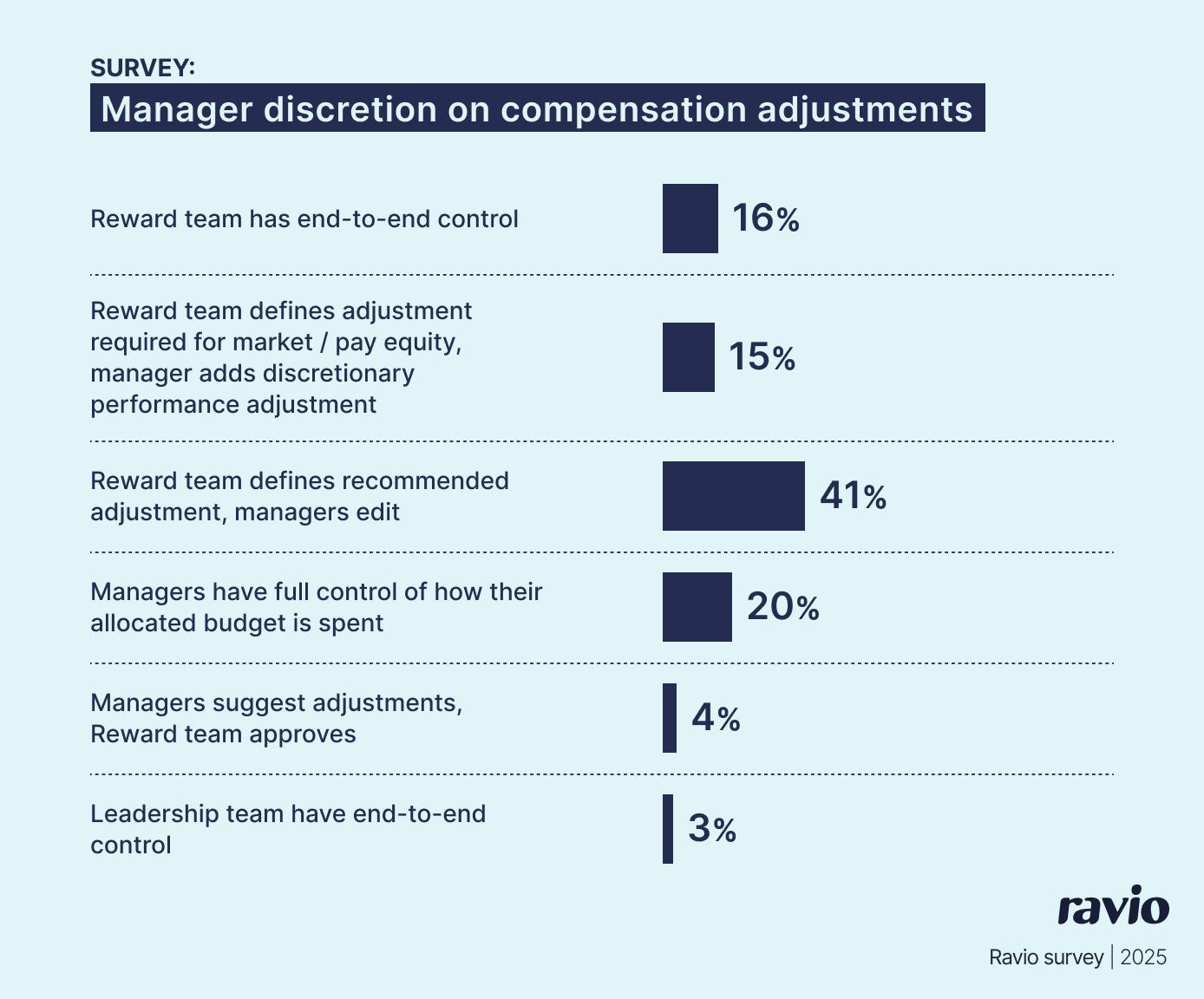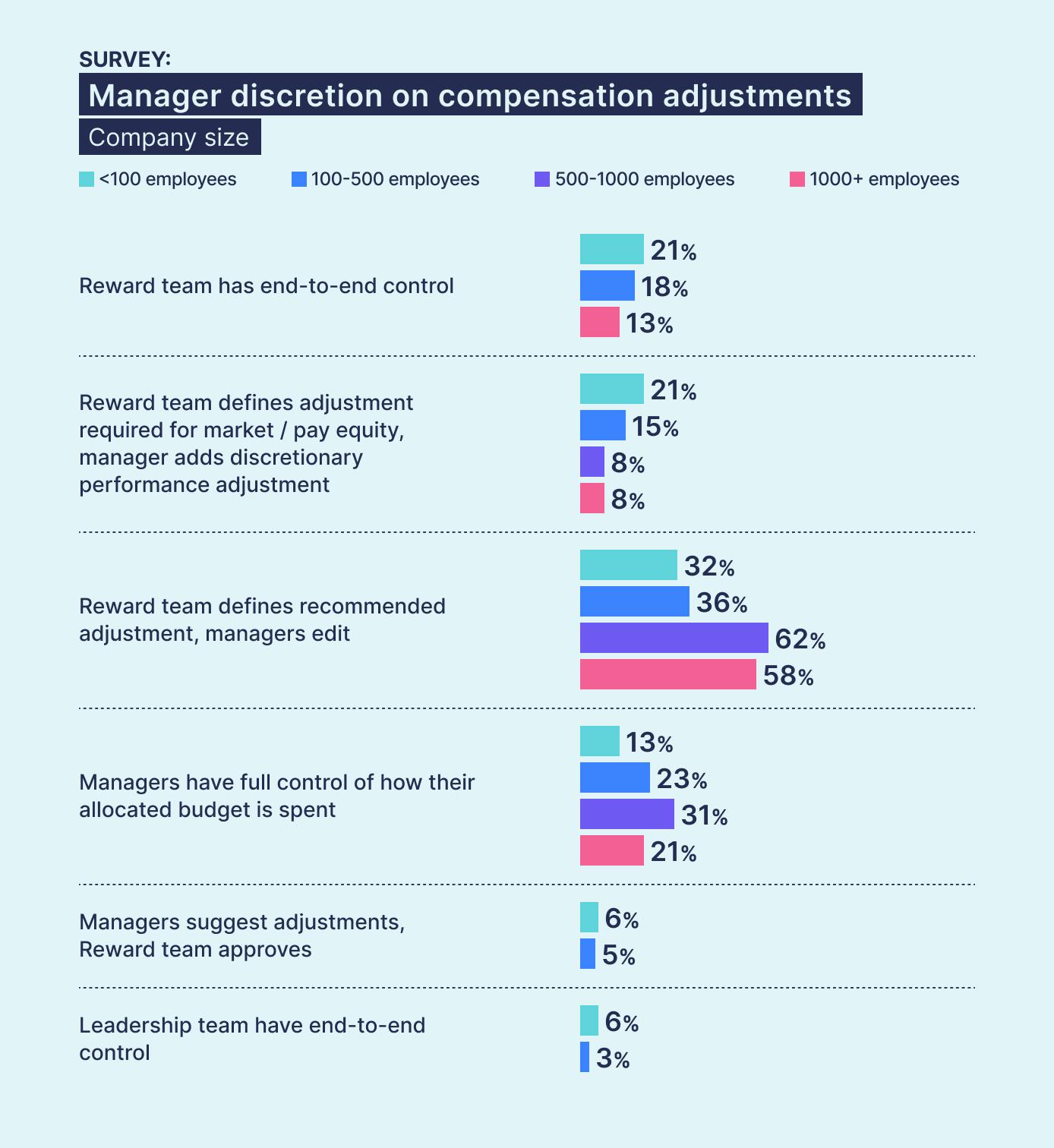Engineering Lead has given their three star performers a 15% increase each.
Sales Lead is spreading their budget evenly across the team peanut butter style to "keep everyone happy."
Meanwhile, your Marketing Lead hasn't submitted their recommendations because they're "still thinking about it" (read: doesn’t feel confident making the decisions).
The question of how much discretion line managers should have over their team's salary increases during compensation reviews is a tricky one.
Give them too much freedom, and you risk creating inconsistencies and inequities that could land you in hot water with increasingly stringent pay transparency regulations.
Centralise decisions too much, and managers start to feel that they lack ownership and influence over how their team are recognised, rewarded, and retained.
So what’s the right balance?
We found some answers in our recent pay review survey of 140 HR and Reward teams – and even more insights when we asked Marie Richter, HR Consultant and Strategic Advisor, for her advice.
Subscribe to our newsletter for monthly insights from our compensation dataset and network of experts, to help you navigate a career in Rewards 📩
How 140 companies approach managerial discretion in salary review decisions
When we asked HR and Reward Leaders who has ownership over salary adjustment decisions during their compensation review process, the most common approach was collaborative: in 41% of companies Reward teams define recommended adjustments, and line managers can make discretionary changes.
This collaborative approach is particularly popular at larger organisations where 62% of 500-1000 employee companies and 58% of 1000+ companies use this model.
According to Marie Richter, this collaborative model succeeds because it "balances efficiency with contextual decision-making."
While Reward teams bring compensation expertise and data, managers provide crucial context about retention risks, unique contributions, and personal situations that data alone can't capture.
"At one company I worked with, an employee was granted a promotion and asked for it to be rescinded – they were happy with their current role and level of responsibility. Their line manager knew this, but wasn't involved in the decision," Marie explains. "With manager input, that mishap would never have happened."
On the other hand, smaller companies favour more centralised control.
21% keep end-to-end control with Reward teams (vs 16% overall), and 6% give leadership teams full control (vs 3% overall) – likely reflecting the ability to manage compensation decisions centrally with smaller teams, as well as perhaps the reduced management experience that managers in smaller organisations often have.
Mid-size companies (500-1000 employees) are most likely to give managers full budget control, with 31% allowing managers end-to-end discretion over their team's adjustments.
Examples: Different levels of manager discretion
CrowdBuilding: HR team maintains full control (100 HC)
Why it works: As a 15-person startup with a flat hierarchy, CrowdBuilding's HR Lead maintains end-to-end control over all compensation decisions. With no traditional management structure, centralised control brings structure, consistency, and fairness to how compensation and employee progression are managed.
Storyblok: Guided flexibility through merit ranges (100-500 HC)
Why it works: Storyblok's Reward team defines a recommended range for salary increases based on market competitiveness and performance ratings (e.g. 4-4.8%increase for exceeding expectations). Managers then choose where each employee sits within that range based on individual context. This gives managers meaningful flexibility to retain the talent they need, whilst maintaining systematic fairness through performance-based guardrails and market competitiveness.
Skyscanner: Systematic process with challenge rights (1000+ HC)
Why it works: Skyscanner uses an automated process where the Reward team controls compensation decisions based on performance ratings, experience, and peer comparisons. Managers can challenge specific recommendations but have limited discretion to override the systematic approach. This ensures fairness and consistency across their large global workforce whilst preventing bias from affecting compensation decisions.
Showpad: Team leads own outcomes with phased enablement (100-500 HC)
Why it works: Showpad's Reward team evaluates market data, pay equity, and performance inputs and provides this information to team leads who have full control over compensation decisions for their teams – with a final review by the CEO and Director of Total Rewards. Currently this is limited to VPs and Directors, with the capability being systematically built across management layers over time, aiming to eventually have people managers owning the process. This phased approach ensures decision-making quality through strong understanding, whilst building toward line manager ownership by the people with the best context on individual employee needs.
The pros and cons of giving managers discretion over pay adjustments
Like most things in compensation, there’s no ‘right’ or ‘wrong’ on whether line managers should be given the discretion to define the salary increases for their direct reports – it all depends on what makes sense for your company’s context.
The pros of managerial discretion in salary reviews:
- Managers have additional context. Line managers work closely with their teams daily, understanding performance nuances that data alone can't capture. Marie Richter shared the important example that managers hold "critical retention intelligence – they know who's at flight risk, who's been approached by recruiters, or who's unhappy."
- Builds ownership and accountability. Supporting a team's performance and progression is vital to every line manager's role. Being more involved in salary decisions strengthens this accountability and, as Marie explains, creates "psychological buy-in – they become partners in the process rather than messengers of decisions made elsewhere."
The cons of manager discretion:
- Inconsistent decisions across teams. Even with the best guidelines in the world, different managers will inevitably make slightly different decisions on how to divide their budget across their team, which creates unfair disparities across departments – something that will become increasingly problematic as legislation like the EU Pay Transparency Directive is rolled out.
- Unconscious bias affects outcomes. From affinity bias to recency bias, personal relationships can significantly impact decision-making.
- Lack of compensation expertise impacts the quality of decisions. If line managers don’t have a strong understanding of how compensation works, they may make decisions that don’t align with the company’s pay philosophy or structures. Marie observes that it’s common for untrained managers to take a ‘peanut butter approach’, "giving everyone similar increases to avoid conflict, which can undermine an entire performance-based pay philosophy."
So if you want to allow for managerial discretion in salary increase decisions, whilst avoiding the risks highlighted here, how should you approach it? We asked Marie for her best advice.
Making line manager discretion work in practice: Expert tips for Reward teams
We asked Marie Richter, HR Consultant and Strategic Advisor, for her battle-tested advice on making manager discretion work. Here's what she shared.

Define your strategic approach to manager discretion upfront
“First and foremost, you need strategic clarity on what level of line manager input makes sense for your company,” Marie explains.
“Maybe you have a culture where managers have a lot of ownership for their teams, so it makes sense for managers to lead the recommendations. Or a market-focused compensation philosophy that means HR should be leading with data on market adjustments needed. Or maybe business isn’t doing well and it’s a tight budget year, so everyone’s getting minimal increases and there’s really very little room for manager involvement.”
This clarity is especially crucial as you scale.
"The 'right' approach depends on company size," Marie notes. "What works at 50 employees won't work at 500. Smaller companies can afford more manager autonomy with natural visibility and easier calibration. As companies scale, more structure and guardrails become necessary."
Without upfront alignment, it’s easy to end up with confusion. "If managers are highly involved in people decisions overall but excluded from salary decisions, it creates inconsistency."
So start by determining what level of manager input makes sense for your company's size, culture, and management philosophy. Then explicitly define what Marie calls “decision rights” – who has final decision-making authority (or vetoes) and who inputs on the decision.
“Beyond just defining involvement levels, you need strategic clarity on decision rights: be explicit about who has final decision-making authority versus who provides input."

HR Consultant
Define who communicates decisions, not just who makes them
Cementing the decision-making process is only half the battle. You also need crystal-clear communication responsibilities, or even the best compensation review can fall apart.
"Who will communicate what to employees, and when? What can managers discuss with their teams during the process? What's confidential until decisions are finalised?" Marie emphasises these questions need answering upfront.
HR typically owns centralised communications about timelines, objectives, process, and overall outcomes – but must communicate this to managers first and keep them updated.
Marie learned this the hard way: "At one company, I moved the effective date of salary increases back by a month or two. Even though I had aligned with most of the leadership, I hadn't considered that one manager had already made promises to team members based on previous cycles."
Managers typically handle one-to-one conversations about individual compensation changes. But HR must ensure they're fully prepared with context on pay decision rationale and training for difficult conversations.
"Being able to explain compensation decisions is crucial," she explains. "Employees need to understand why they're receiving an increase (or not), when the next one might be due, why the next one might not be as high, or that they're being supported for promotion but aren't quite ready yet and what development they need to get there."
"Managers will inevitably get questions from their team. They need clear guidance on what they can and cannot say to avoid making premature promises or sharing inconsistent information."
When those conversations don't go well? Establish an appeals process before you need it. "What happens if an employee disagrees with their compensation decision? Is there a formal appeals process? Who handles it? This should be decided before the cycle starts, not when the first complaint arrives."
Lead with HR expertise, then add manager context
"The most popular approach in your data – that collaborative model – works because it balances efficiency with contextual decision-making," Marie explains.
HR should start with what they know best: refreshing market benchmarks, updating salary bands, flagging pay equity issues, and calculating what's needed to keep people in-line with your compensation philosophy.
Then manager input becomes critical to provide additional context on employee concerns, progression plans, and rewards preferences.
"Managers provide crucial context about retention risks, personal situations, unique contributions that don't show up in performance ratings, or market pressures for specific roles,” she explains.
“They know (or should know) who's at flight risk, who's been approached by recruiters, or who's unhappy. This level of insight doesn't live in HRIS systems and is essential for strategic compensation decisions."
For managers, the collaborative model works because it creates what Marie calls "psychological ownership and buy-in. When managers have input rather than just executing HR's decisions, they're more likely to own and defend the outcomes to their teams."
"The real value lies in balancing data-driven decisions with human judgment. Managers know who's at flight risk, who's been approached by recruiters, who's unhappy. This context doesn't live in HRIS systems."

HR Consultant
Build manager confidence through targeted enablement
Manager training is where most companies drop the ball.
"Like with most HR and people management topics, when manager discretion goes wrong it's usually because of a lack of proper manager training," Marie states.
If you're allowing managers discretion in pay decisions, they must understand "the current state of the business, its priorities, and how to make fair, effective compensation decisions in line with your pay principles," Marie emphasises. Without this context, they can't properly weigh competing priorities or exercise discretion effectively.
Many managers struggle with tough calls. "Some managers avoid hard decisions by giving everyone similar increases to avoid conflict, which undermines the entire philosophy if you have performance-based pay," Marie observes.
Beyond pre-review training, Marie recommends ongoing support: office hours for questions, training videos, and Q&A documents built from previous cycles.
The goal is helping managers see the bigger picture. "Compensation decisions shouldn't be looked at in isolation, but in the whole context of the employee – their career journey, desires and ambitions, expectations, life circumstances, and what truly motivates them," Marie notes.
She observed one exceptional manager who embodied this approach: "They supported people in their career journeys by proactively finding parallel moves internally, securing stretch assignments, and helping them grow – even when compensation increases weren't possible."
Use guardrails, calibration, and HR checks to ensure consistency
Even with great training, managers need clear boundaries and structured checkpoints to ensure fair decisions across teams.
Start with the guardrails. Marie's learned what works:
- Pre-populated HR recommendations that managers can override with guidelines
- Percentage bands rather than fixed amounts (e.g. "2-5% based on performance") to maintain flexibility when budgets are tight
- Required justification for any overrides
- Escalation thresholds for exceptions requiring HR approval.
Then, build in HR checks too: "once before the cycle kicks off to be aware of any outliers that need correcting, and again before the salary decisions are finalised."
This maintains oversight, ensuring all decisions are consistent and fair (including, crucially, not damaging pay equity), whilst preserving manager ownership.
"Provide structure and support that empowers managers to make good decisions, rather than controls that make them feel they have no real input."

HR Consultant
Consider how technology can enable better manager input
The right technology can make or break your manager discretion process.
"If you have a compensation tool where recommendations can be pre-populated based on performance ratings, manager involvement is more straightforward," Marie notes.
But without proper tooling, "managers' involvement gets trickier because you don't want all managers accessing the same spreadsheet with sensitive employee data."
It’s easy to see how errors can creep in when pay reviews are managed through spreadsheets, or how a manager sharing information they shouldn’t can lead to a data privacy breach.
This creates the balance Marie advocates for: managers can exercise discretion effectively while HR maintains oversight through clear approval workflows and real-time visibility into budget and pay equity impacts.
As Marie emphasises throughout, the goal is empowering managers while maintaining control.
The right technology makes this achievable.
Review and refine your approach after every single cycle
The compensation review doesn't end when increases are communicated. Without a proper review, “companies repeat the same mistakes year after year."
"For all HR programmes it’s important to review their success after each cycle is complete to identify improvements for next time – and compensation reviews are no exception,” Marie advises. "Document these lessons in the project plan for the next round."
Gather feedback while it's fresh – from managers who made decisions, employees who received them, and the HR team who ran the process. Where did managers struggle? Which guardrails helped versus hindered? Did communication break down anywhere?
The feedback loop also builds manager capability over time. "Listen to feedback from previous cycles and incorporate common questions into Q&A documents," Marie suggests. Each cycle's challenges become next year's improved processes and training materials.





